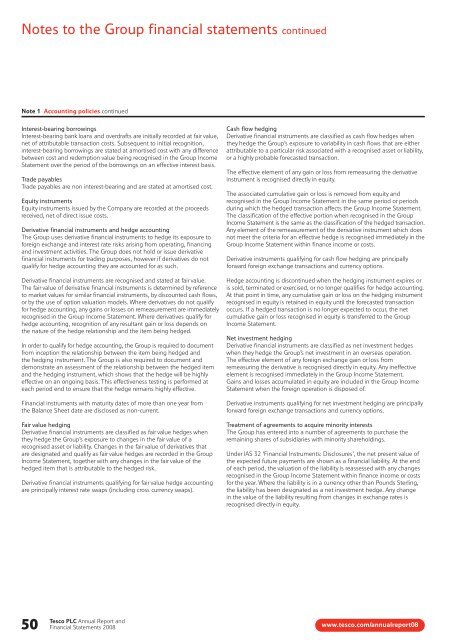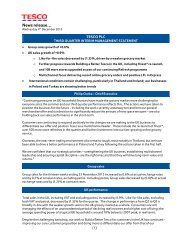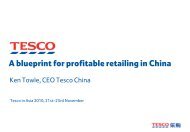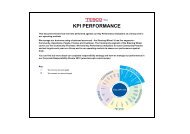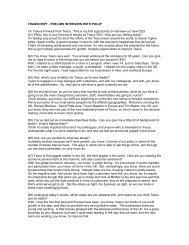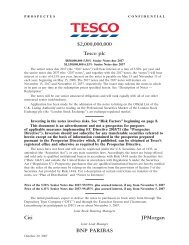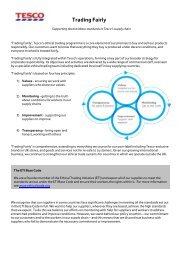Tesco plc Annual Report and Financial Statements 2008
Tesco plc Annual Report and Financial Statements 2008
Tesco plc Annual Report and Financial Statements 2008
You also want an ePaper? Increase the reach of your titles
YUMPU automatically turns print PDFs into web optimized ePapers that Google loves.
Notes to the Group financial statements continued<br />
Note 1 Accounting policies continued<br />
Interest-bearing borrowings<br />
Interest-bearing bank loans <strong>and</strong> overdrafts are initially recorded at fair value,<br />
net of attributable transaction costs. Subsequent to initial recognition,<br />
interest-bearing borrowings are stated at amortised cost with any difference<br />
between cost <strong>and</strong> redemption value being recognised in the Group Income<br />
Statement over the period of the borrowings on an effective interest basis.<br />
Trade payables<br />
Trade payables are non interest-bearing <strong>and</strong> are stated at amortised cost.<br />
Equity instruments<br />
Equity instruments issued by the Company are recorded at the proceeds<br />
received, net of direct issue costs.<br />
Derivative financial instruments <strong>and</strong> hedge accounting<br />
The Group uses derivative financial instruments to hedge its exposure to<br />
foreign exchange <strong>and</strong> interest rate risks arising from operating, financing<br />
<strong>and</strong> investment activities. The Group does not hold or issue derivative<br />
financial instruments for trading purposes, however if derivatives do not<br />
qualify for hedge accounting they are accounted for as such.<br />
Derivative financial instruments are recognised <strong>and</strong> stated at fair value.<br />
The fair value of derivative financial instruments is determined by reference<br />
to market values for similar financial instruments, by discounted cash flows,<br />
or by the use of option valuation models. Where derivatives do not qualify<br />
for hedge accounting, any gains or losses on remeasurement are immediately<br />
recognised in the Group Income Statement. Where derivatives qualify for<br />
hedge accounting, recognition of any resultant gain or loss depends on<br />
the nature of the hedge relationship <strong>and</strong> the item being hedged.<br />
In order to qualify for hedge accounting, the Group is required to document<br />
from inception the relationship between the item being hedged <strong>and</strong><br />
the hedging instrument. The Group is also required to document <strong>and</strong><br />
demonstrate an assessment of the relationship between the hedged item<br />
<strong>and</strong> the hedging instrument, which shows that the hedge will be highly<br />
effective on an ongoing basis. This effectiveness testing is performed at<br />
each period end to ensure that the hedge remains highly effective.<br />
<strong>Financial</strong> instruments with maturity dates of more than one year from<br />
the Balance Sheet date are disclosed as non-current.<br />
Fair value hedging<br />
Derivative financial instruments are classified as fair value hedges when<br />
they hedge the Group’s exposure to changes in the fair value of a<br />
recognised asset or liability. Changes in the fair value of derivatives that<br />
are designated <strong>and</strong> qualify as fair value hedges are recorded in the Group<br />
Income Statement, together with any changes in the fair value of the<br />
hedged item that is attributable to the hedged risk.<br />
Derivative financial instruments qualifying for fair value hedge accounting<br />
are principally interest rate swaps (including cross currency swaps).<br />
50<br />
<strong>Tesco</strong> PLC <strong>Annual</strong> <strong>Report</strong> <strong>and</strong><br />
<strong>Financial</strong> <strong>Statements</strong> <strong>2008</strong><br />
Cash flow hedging<br />
Derivative financial instruments are classified as cash flow hedges when<br />
they hedge the Group’s exposure to variability in cash flows that are either<br />
attributable to a particular risk associated with a recognised asset or liability,<br />
or a highly probable forecasted transaction.<br />
The effective element of any gain or loss from remeasuring the derivative<br />
instrument is recognised directly in equity.<br />
The associated cumulative gain or loss is removed from equity <strong>and</strong><br />
recognised in the Group Income Statement in the same period or periods<br />
during which the hedged transaction affects the Group Income Statement.<br />
The classification of the effective portion when recognised in the Group<br />
Income Statement is the same as the classification of the hedged transaction.<br />
Any element of the remeasurement of the derivative instrument which does<br />
not meet the criteria for an effective hedge is recognised immediately in the<br />
Group Income Statement within finance income or costs.<br />
Derivative instruments qualifying for cash flow hedging are principally<br />
forward foreign exchange transactions <strong>and</strong> currency options.<br />
Hedge accounting is discontinued when the hedging instrument expires or<br />
is sold, terminated or exercised, or no longer qualifies for hedge accounting.<br />
At that point in time, any cumulative gain or loss on the hedging instrument<br />
recognised in equity is retained in equity until the forecasted transaction<br />
occurs. If a hedged transaction is no longer expected to occur, the net<br />
cumulative gain or loss recognised in equity is transferred to the Group<br />
Income Statement.<br />
Net investment hedging<br />
Derivative financial instruments are classified as net investment hedges<br />
when they hedge the Group’s net investment in an overseas operation.<br />
The effective element of any foreign exchange gain or loss from<br />
remeasuring the derivative is recognised directly in equity. Any ineffective<br />
element is recognised immediately in the Group Income Statement.<br />
Gains <strong>and</strong> losses accumulated in equity are included in the Group Income<br />
Statement when the foreign operation is disposed of.<br />
Derivative instruments qualifying for net investment hedging are principally<br />
forward foreign exchange transactions <strong>and</strong> currency options.<br />
Treatment of agreements to acquire minority interests<br />
The Group has entered into a number of agreements to purchase the<br />
remaining shares of subsidiaries with minority shareholdings.<br />
Under IAS 32 ‘<strong>Financial</strong> Instruments: Disclosures’, the net present value of<br />
the expected future payments are shown as a financial liability. At the end<br />
of each period, the valuation of the liability is reassessed with any changes<br />
recognised in the Group Income Statement within finance income or costs<br />
for the year. Where the liability is in a currency other than Pounds Sterling,<br />
the liability has been designated as a net investment hedge. Any change<br />
in the value of the liability resulting from changes in exchange rates is<br />
recognised directly in equity.<br />
www.tesco.com/annualreport08


